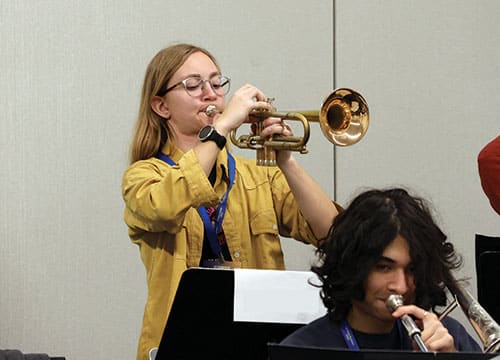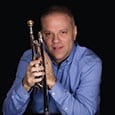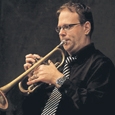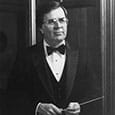Starting Players on Cornet
Introducing young students to brass instruments requires careful consideration to ensure a positive experience on their fresh, musical journey. Deciding to start young trumpet students on the cornet, rather than the trumpet, presents several advantages with minimal drawbacks.
While the trumpet and cornet share the same length of tubing, their main distinction lies in their respective shapes. The cornet features a more compact and conical shape, while the trumpet exhibits an elongated cylindrical form. Understanding the differences between conical and cylindrical shapes is crucial.
The conical shape of the cornet entails a gradual widening from the mouthpiece to the bell, resembling a ice cream cone. This shape promotes a more focused and mellow sound, offering better control over intonation and enhanced responsiveness for softer dynamics. Conical instruments, including the cornet, are known for a warm and rich sound.
On the other hand, cylindrical shapes maintain a consistent diameter throughout the instrument. This shape enables a brighter and more powerful sound, lending versatility and the ability to produce a wide range of dynamic and expressive sound to cylindrical instruments like the trumpet.
The decision to select between conical and cylindrical instruments should be based on the desired sound and playing style. Conical shapes generally provide a more lyrical and expressive quality, while cylindrical shapes deliver a more brilliant and projecting sound.
A primary advantage of starting young trumpet students on the cornet is improved tone production. The cornet’s conical bore and mellower sound provide a gentle introduction to brass playing. Its smaller bore diameter encourages students to focus on embouchure, breath control, and technique, establishing a solid foundation for future trumpet playing.
The conical shape of the cornet’s bore contributes to improved tone production in several ways. First, the gradual widening of the bore from mouthpiece to bell allows for a more focused and centered sound. This means that the vibrations produced by the player’s lips are channeled, focused, and concentrated, resulting in a more centered and mellow tone.
The conical shape also facilitates better control of intonation. As the diameter of the bore gradually increases, it helps to balance the harmonics and overtones produced by the instrument, producing more accurate and in-tune playing, particularly in the lower register. In addition, the conical shape provides enhanced responsiveness at softer dynamics. The gradual tapering of the bore leads to a quicker and more controlled response when playing at lower volumes. This is particularly useful in melodic and lyrical passages where a gentle and expressive tone is desired. Overall, the conical shape of the cornet contributes to a warm, rich, and expressive sound, making it an excellent choice for beginners and those seeking a mellower tone.
Another advantage of starting on the cornet is the better weight and balance it offers. The cornet’s compact and balanced design permits easier and more comfortable playing. Its smaller size and lighter weight reduce strain and fatigue, letting students concentrate on developing embouchure, maintaining proper hand position, finger technique, and overall musicality. These attributes also make it more manageable for students who are smaller or have a delicate physical build. In contrast, a trumpet tends to be heavier at the bell, which can contribute to more tension in the wrists, especially for beginners. With the cornet, the weight of the instrument tends to be distributed and balanced towards the backside, near the shepherd crook in the bell and mouthpiece, resulting in more balanced and ergonomic playing.
Starting on the cornet cultivates a heightened sensitivity to sound. Students learn to listen attentively to their own playing, developing a discerning ear for intonation, tone quality, and musical expression. This keen sound awareness enhances their ability to play in tune and blend effectively with other musicians, fostering their development as well-rounded and accomplished musicians.
Students also find that it is a seamless transition to the trumpet. Skills and techniques acquired on the cornet effortlessly transfer to the trumpet. Students with a solid foundation in tone production, technique, and musical interpretation experience a smoother transition, minimizing frustration when learning a new instrument. This continuity allows them to focus on refining their skills rather than starting from scratch, accelerating their progress.
Beyond the musical benefits, starting on the cornet builds confidence in young players. As they develop their skills on a more manageable instrument, they gain a sense of accomplishment and self-assurance. This confidence carries over to their trumpet playing, enabling them to tackle more challenging musical passages and perform with greater ease.
The only true disadvantage to starting on the cornet arises when only one student in a beginner class begins on the cornet. In such cases, it is essential to explain that there is no significant difference between starting on the cornet versus the trumpet. The teacher must address any concerns or questions from the other students regarding the cornet players in the class, providing accurate and comprehensive information about both instruments. The goal is to create an inclusive and cohesive group dynamic, ensuring that the student on the cornet does not feel singled out or left behind.
In closing, starting trumpet students on the cornet offers numerous advantages that significantly encourage musical development. The improved tone production, better weight and balance, seamless transition to the trumpet, enhanced sound development, and heightened sensitivity to sound are just a few of the benefits. Moreover, starting on the cornet builds valuable skills and fosters confidence. The cornet serves as an ideal and practical starting point, setting young musicians on a path of excellence.
Focus on the Lower Range
The lower range of the trumpet is unfortunately overshadowed by the heroic monster of the first trumpeter’s high register. This emphasis on the first trumpet, particularly among younger musicians, neglects the essential contributions of second and third players. It is essential to correct this imbalance and make sure that that the entire trumpet section feels valued as contributors, regardless of the number marked on their parts.

Audiences members and students, tend to focus on the impressive brilliance, power, and flash found in the upper registers of the trumpet, leaving the lower range relatively unexplored and forgotten. However, when these lower notes are written into a piece, we should treat them with the attention they deserve. Unfortunately, in assigning second and third parts, we often underestimate the abilities of our students in this range, as we have not spent sufficient time developing their low register skills. As a result, these students may struggle with instability and uncertainty. It is imperative to shift this mindset and prepare our lower section players with the necessary skills and confidence to play effectively and reliably in their lower range.
While I understand that the low range may not be the most glamorous job in the trumpet section, with dedicated practice, we can transform students’ timid and unsteady entrances into clear and controlled sounds. This improvement will extend not only to the low range but to all registers of their trumpet.
When playing in the low range, it is crucial for students to anchor their corners and keep their embouchure as relaxed as possible. This range demands a significant amount of air. Surprisingly, by maintaining relaxed embouchure within the corners, they will encounter minimal resistance for the airstream. This relaxation widens the aperture of their embouchure, allowing unrestricted vibrations to pass through the lips and into the mouthpiece. However, if their sound lacks depth and strength, it may indicate excessive tension in the embouchure. In such cases, tongue placement becomes an important factor. Students should be reminded to drop the back of their tongue, producing a vowel sound akin to oh.
It is important to note that with the tongue positioned lower in the mouth, quicker tongue movements are necessary for articulation. Unfavorable tongue angles can present challenges in achieving rapid articulations when playing in the low range. Additionally, the lower pressure of air in this range may not immediately move the tongue, resulting in a prolonged contact with the hard palate (alveolar ridge). This can create an unintended gap between notes. To address this, students should strive for using faster, fatter air, quicker tongue movements to compensate for the lower tongue angle.
Developing their low range skills will not only expand their musical capabilities but also provide a more solid foundation for technical proficiency across all registers. It is also important to emphasize that low range practice is not exclusive to third players. This discipline should be cultivated among the entire section, providing equal opportunities for growth. Additionally, practicing in the low range can benefit those aspiring to play higher by instilling the necessary micro-movements, albeit with reduced pressure on the embouchure muscles. As a well-known saying in the trumpet realm goes, “To play high, practice low.”






